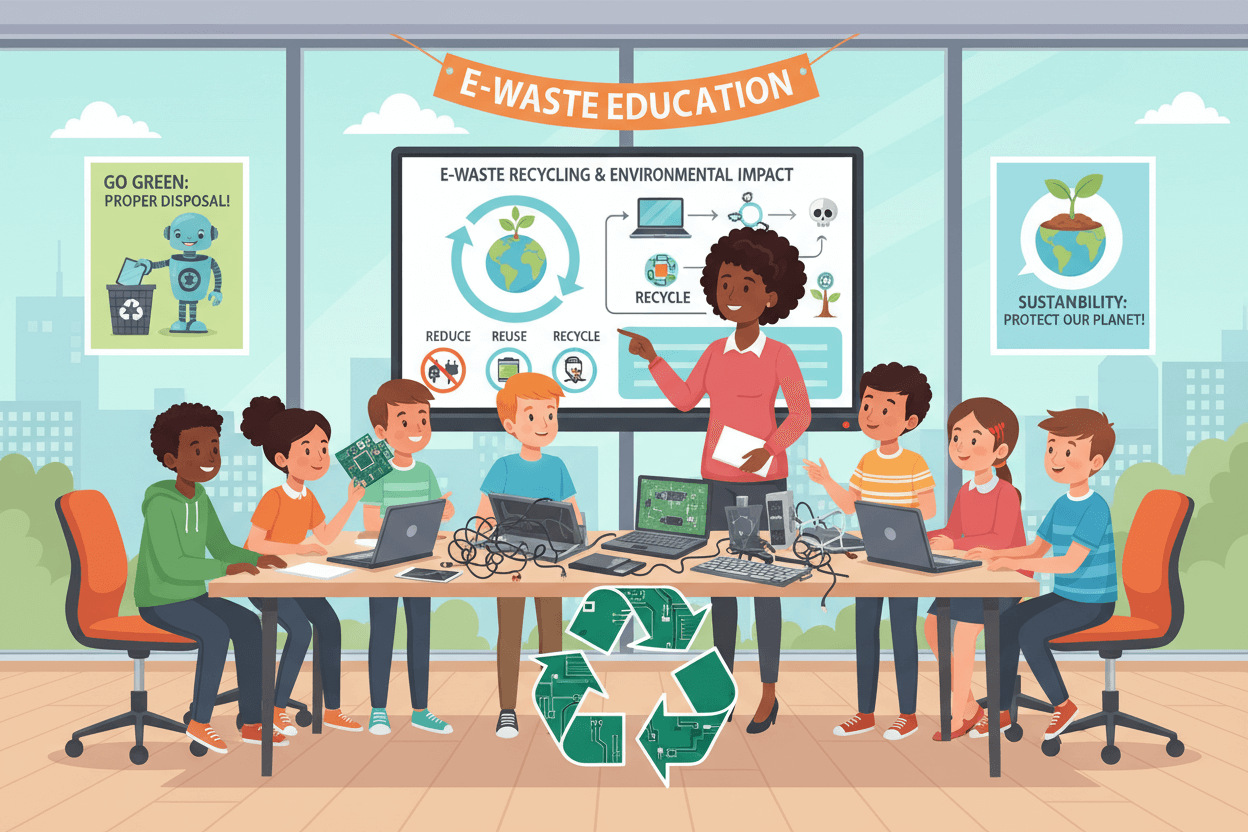Schools must educate students about growing e-waste concerns.

Introduction
As the world becomes increasingly digital, electronic devices have become part of everyday life. From smartphones and laptops to tablets and smartwatches, technology plays a crucial role in education and communication. However, the rise of gadgets has also led to a serious environmental problem — electronic waste (E-waste). Schools today must take a leading role in raising awareness about the impact of E-waste, its proper disposal, and recycling methods. Educating students about E-waste concerns can foster environmental responsibility and sustainable habits from an early age, ensuring that future generations are conscious consumers and protectors of the planet.
Understanding E-Waste — A Global Environmental Challenge
E-waste refers to discarded electronic devices like old phones, computers, and other gadgets. As technology advances rapidly, consumers replace their devices frequently, leading to an alarming buildup of waste. According to international reports, the world generates over 50 million tonnes of E-waste annually, and less than 20% is properly recycled.
Much of this waste contains toxic substances such as lead, mercury, and cadmium, which can pollute soil, water, and air when not disposed of correctly. In many countries, including India and the UAE, informal recycling and dumping of E-waste create severe health and environmental risks. Schools can help address this issue by educating young people on responsible E-waste management and sustainable electronic use.
Why Schools Play a Vital Role in Tackling E-Waste
Schools are the foundation for building awareness, behavior, and social responsibility. When teachers integrate lessons on E-waste concerns into science, environmental studies, and social education, students learn the importance of proper disposal and recycling of electronic devices.
Here’s why schools are crucial in combating E-waste:
-
Early Awareness: Teaching students early helps them form environmentally conscious habits.
-
Community Influence: Students often share what they learn with their families and communities.
-
Practical Initiatives: Schools can organize E-waste drives, recycling workshops, and awareness campaigns.
-
Long-Term Impact: Educated students become responsible consumers and future decision-makers.
When schools lead by example, they empower students to become active participants in protecting the environment and reducing the burden of E-waste.
How Schools Can Educate Students About E-Waste
There are several creative and effective ways schools can raise awareness about E-waste and promote eco-friendly behavior:
1. Integrate E-Waste Education into Curriculum
Subjects like environmental science, technology, and geography can include lessons on the causes, effects, and solutions to E-waste. Teachers can discuss the recycling process, the dangers of toxic components, and how students can help reduce E-waste in their daily lives.
2. Organize E-Waste Collection Drives
Schools can collaborate with certified recyclers to collect old electronic devices such as batteries, chargers, phones, and computers. Students can bring unused electronics from home to participate. Such initiatives make learning practical and impactful.
3. Promote Repair and Reuse Culture
Encouraging students to repair rather than replace electronic devices teaches sustainability. Schools can hold workshops on device maintenance, repair basics, and creative reuse of old gadgets.
4. Involve Parents and Communities
Schools can extend awareness campaigns to parents through newsletters, webinars, and joint recycling events. When families participate, the collective impact is stronger, reinforcing the message beyond the classroom.
The Impact of E-Waste on Health and Environment
Improper disposal of E-waste has serious consequences. Toxic metals and chemicals from discarded electronics can seep into soil and water, harming humans, animals, and plants. In many developing regions, informal E-waste recycling involves burning wires or dismantling gadgets by hand — exposing workers and children to hazardous fumes.
Health effects of E-waste include:
-
Respiratory problems from inhaling toxic fumes.
-
Neurological damage due to heavy metals like lead and mercury.
-
Skin diseases caused by direct contact with hazardous components.
-
Water contamination from leaching chemicals into groundwater.
By understanding these dangers, students realize why proper disposal and recycling of E-waste is essential for community health and environmental preservation.
Encouraging Sustainable Digital Habits Among Students
Teaching digital responsibility is just as important as environmental awareness. Schools can help students make smarter choices about using and disposing of technology. Some strategies include:
-
Buying only what’s necessary: Avoiding unnecessary upgrades and impulse gadget purchases.
-
Proper device maintenance: Keeping devices clean, updated, and in good condition for longer use.
-
Recycling old electronics: Ensuring obsolete gadgets are handed to authorized recycling centers.
-
Using digital tools efficiently: Minimizing electricity and data consumption to lower environmental impact.
-
Participating in recycling programs: Supporting school and community efforts to manage E-waste responsibly.
When these practices become part of daily life, students naturally contribute to a cleaner, more sustainable future.
Technology and Responsibility — Creating a Balanced Mindset
While technology enhances education and connectivity, it’s vital that students learn to balance innovation with sustainability. Schools can emphasize “green technology” — the design and use of devices that minimize environmental impact.
By showcasing companies and initiatives that prioritize recycled materials and energy-efficient manufacturing, educators can inspire students to think critically about the products they use. Moreover, encouraging careers in environmental technology or sustainable engineering can motivate young minds to design future solutions for the E-waste crisis.
The Role of Teachers in Shaping Eco-Conscious Learners
Teachers are the bridge between knowledge and action. By fostering a classroom culture that values sustainability, teachers can influence how students perceive electronic consumption. For instance:
-
Discussing case studies of countries with successful E-waste recycling programs.
-
Demonstrating how simple daily actions — like donating old phones — can make a difference.
-
Inviting environmental experts to speak about waste management and innovation.
-
Encouraging project-based learning, where students create campaigns or models on E-waste reduction.
Empowered teachers can transform E-waste education from a lesson into a lifelong habit among students.
Building the Next Generation of Green Leaders
By teaching students about E-waste concerns, schools help nurture responsible citizens who can drive sustainable development in the future. When young people understand how their digital behavior affects the environment, they are more likely to:
-
Advocate for recycling programs.
-
Choose eco-friendly products.
-
Participate in sustainability campaigns.
-
Influence family and community decisions.
In essence, today’s students are tomorrow’s leaders — and giving them the knowledge and motivation to tackle E-waste ensures a cleaner, safer planet for all.
Challenges Schools Face in E-Waste Education
While the importance is clear, many schools face challenges implementing E-waste awareness programs:
-
Lack of resources to organize drives or workshops.
-
Limited access to certified recyclers in certain regions.
-
Insufficient teacher training on the technical aspects of E-waste.
-
Low parental awareness, which reduces participation.
To overcome these barriers, schools can collaborate with government agencies, NGOs, and private recyclers to create structured programs and training sessions. Partnerships can provide materials, logistical support, and real-world examples to make E-waste education effective and engaging.
Practical Steps for Schools to Implement E-Waste Awareness Programs
-
Conduct surveys to assess electronic usage among students.
-
Set up collection bins for safe disposal of batteries and small gadgets.
-
Collaborate with recyclers for proper waste management.
-
Launch eco-clubs focused on sustainability and recycling.
-
Organize competitions such as poster-making or debates on E-waste reduction.
-
Integrate digital literacy with sustainability lessons to build holistic awareness.
Small, consistent actions lead to a long-term cultural shift — creating a generation that understands technology’s power and its responsibilities.
Conclusion
Educating students about E-waste concerns is no longer optional — it’s essential. As technology evolves, so must our understanding of how to use it responsibly. Schools are uniquely positioned to inspire positive change by teaching sustainable habits, promoting recycling, and encouraging repair culture. When students understand the long-term effects of E-waste, they become advocates for cleaner, greener living. Through awareness, action, and education, schools can help extend the life of electronic products, reduce global waste, and nurture a generation committed to protecting the planet and building a sustainable digital future.
FAQs
Q.1. What is E-waste?
E-waste refers to discarded electronic devices like phones, laptops, and batteries that are no longer in use.
Q.2. Why should schools teach about E-waste?
Because schools can shape young minds to become environmentally responsible and help reduce the growing E-waste problem.
Q.3. How can students help reduce E-waste?
By recycling old gadgets, repairing instead of replacing, and using electronics responsibly.
Q.4. What are the dangers of improper E-waste disposal?
It can release toxic chemicals that harm human health and pollute soil, air, and water.
Q.5. How can teachers promote E-waste awareness?
Through classroom lessons, recycling campaigns, and partnerships with local environmental organizations.





